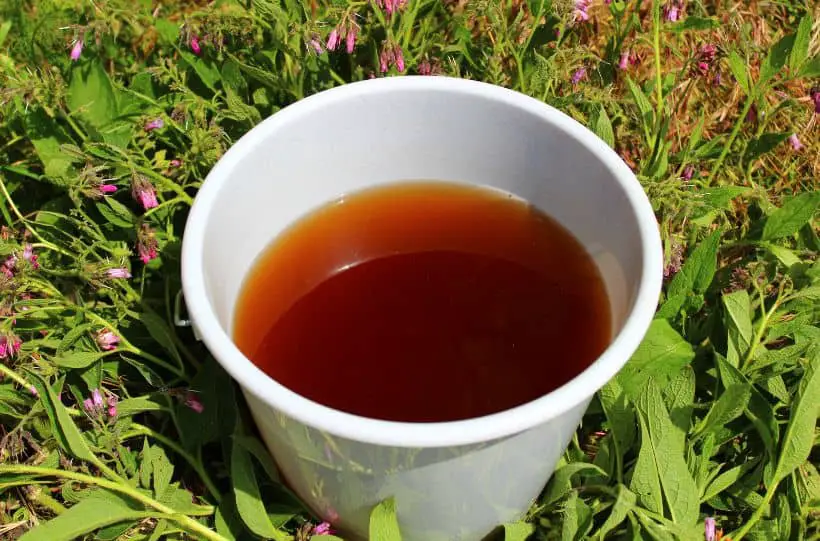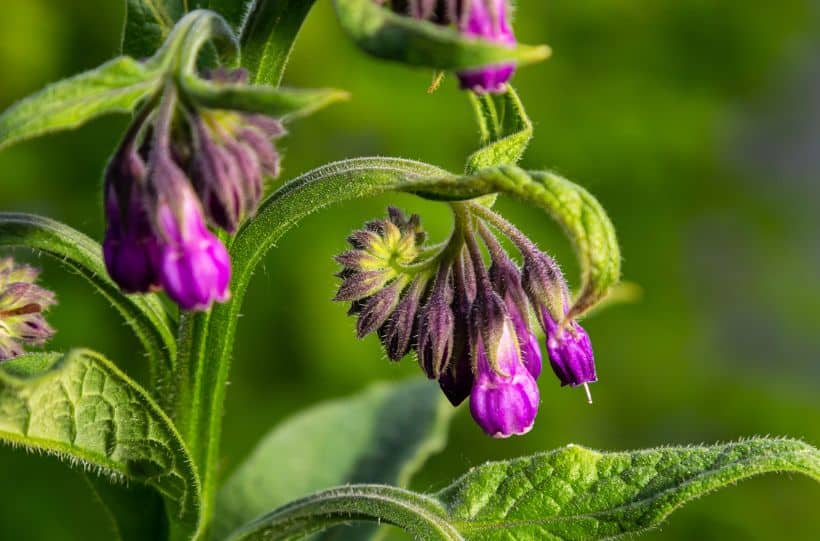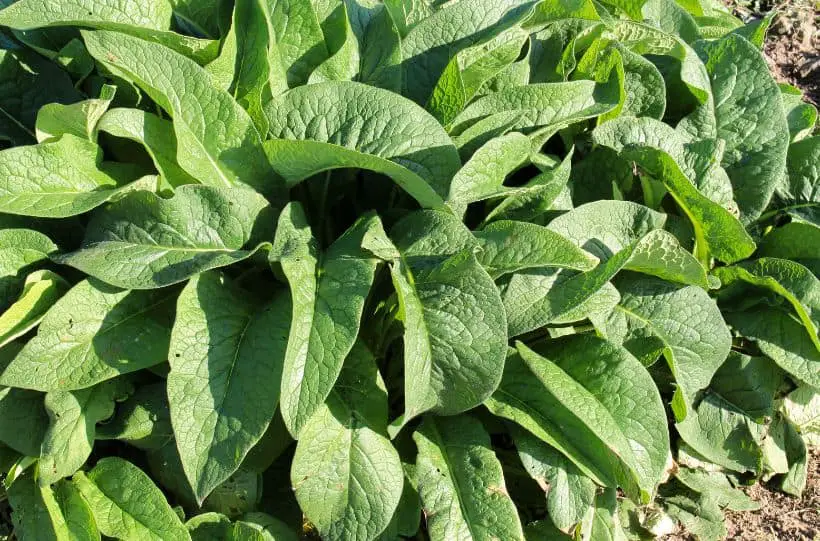Comfrey Tea Fertilizer: Make and Use Comfrey Tea
Comfrey tea is a liquid fertilizer that is easy to make and use for both annual and perennial plants. It is made from the leaves of the comfrey plant, which is known for its high nutrient content.
Comfrey tea is a sustainable and cost-effective way to fertilize plants, especially for those who are looking for an organic option.
Comfrey tea is easy to make and use. To make comfrey tea, comfrey leaves are steeped in water for several weeks until the nutrients are extracted from the leaves. The resulting liquid is then diluted with water and applied to plants as a liquid fertilizer.
Liquid fertilizers are a great way to nourish your plants – they provide nutrients in a readily available form, so they’re quickly absorbed.

What is Comfrey?
Comfrey, a perennial plant with deep roots, is a popular choice among gardeners as a natural fertilizer. Its scientific name is Symphytum officinale, and it is a member of the Boraginaceae family.
Comfrey is a hardy plant that can grow up to 5 feet tall and spread up to 3 feet wide. Comfrey’s very deep roots allow it to absorb nutrients from deep in the soil, making it a valuable addition to any garden.

Its leaves are rich in potassium, nitrogen, and phosphorus, which are the three primary macronutrients that plants need in large quantities. These nutrients are essential for healthy plant growth and development.
In addition to the primary macronutrients, comfrey also contains calcium, magnesium, and trace minerals. Calcium is essential for strong cell walls, while magnesium is necessary for the production of chlorophyll. Trace minerals are essential for plant growth and development but are required in smaller amounts than macronutrients.
What is Comfrey Tea?
Comfrey tea is a nutrient-rich liquid fertilizer that is made from comfrey leaves, a rich deep greenish-brown liquid that is packed with nutrients that plants need to grow and thrive.
Comfrey tea is a great choice for organic gardeners who want to provide their plants with a natural, nutrient-rich feed. It is easy to make and use, and it provides plants with the essential macronutrients they need to grow and thrive.
How to Make Comfrey Tea Fertilizer
Harvesting Comfrey Leaves
To make comfrey tea, you need to harvest comfrey leaves. Comfrey leaves are best harvested when they are in their prime, which is usually before the plant starts flowering.

You can harvest the leaves using shears or scissors. And please note that the hairy leaves can irritate the skin, so wear gloves if necessary.
Diluting and Fermenting the Comfrey Tea
Once the comfrey leaves have been harvested, they need to be chopped into small pieces and placed in a large bucket. The bucket should be filled with water, preferably rainwater, and covered with a lid.
The comfrey leaves will start to rot, and the rotting process will release nutrients into the water. It is recommended to let the mixture ferment for at least three weeks.
After three weeks, the mixture should be strained, and the solid remains discarded. The resulting liquid is comfrey tea.
It is essential to dilute the comfrey tea before using it on plants. One part of comfrey tea should be diluted with ten parts of water. The diluted comfrey tea can then be applied to plants as a foliar spray or used to water the plants.
Making comfrey tea is a sustainable and cost-effective way to provide nutrients to plants. By harvesting comfrey leaves and diluting and fermenting them, one can create a nutrient-rich liquid that can be used to feed plants.
How to Use Comfrey Tea Fertilizer
Comfrey tea is an excellent liquid feed that can be used to fertilize plants. It is easy to make and can be applied to plants in a variety of ways. Here are two common methods for applying comfrey tea:
Using a Watering Can
One of the easiest ways to apply comfrey tea to plants is by using a watering can. Simply dilute the tea with water and pour it over the soil around the base of the plants.
This method is particularly effective for plants that have deep roots, such as tomatoes, peppers, and eggplants. Here’s how:
- Fill the watering can with comfrey tea.
- Dilute the tea with water at a ratio of 1:10 (one part tea to ten parts water).
- Pour the diluted tea over the soil around the base of the plants.
- Repeat every two to three weeks during the growing season.
Foliar Spray Method
Another way to apply comfrey tea is by using a foliar spray. This method is particularly effective for plants that have shallow roots, such as lettuce, kale, and herbs.
The nutrients in the tea are absorbed through the leaves of the plants, providing them with a quick boost of energy. To use the foliar spray method, follow these simple steps:
- Fill a spray bottle with comfrey tea.
- Dilute the tea with water at a ratio of 1:20 (one part tea to twenty parts water).
- Spray the diluted tea over the leaves of the plants, making sure to cover both sides of the leaves.
- Repeat every two to three weeks during the growing season.
It is important to note that foliar spraying should be done early in the morning or late in the evening to avoid burning the leaves of the plants. Additionally, it is recommended to avoid spraying plants during hot and sunny weather.
Comfrey Tea and Soil Health
Comfrey tea is an excellent way to improve soil health in the garden. The tea is rich in nutrients that are essential for plant growth and development. When used as a soil drench or foliar spray, comfrey tea can promote healthy plant growth, increase soil fertility, and improve the overall health of the garden.
One of the main benefits of comfrey tea is its ability to improve soil structure. The tea contains high levels of organic matter, which helps to improve soil texture and water retention. This can be especially beneficial in sandy or clay soils, which tend to be poorly structured and lack the necessary nutrients for plant growth.
Comfrey tea is also rich in potassium, which is essential for plant growth and development. Potassium helps to regulate plant water balance, improve stress tolerance, and promote healthy root growth. This can help to improve plant health and increase yield in the garden.
Another benefit of comfrey tea is its ability to increase soil pH. The tea has a pH of around 7.0, which is neutral. This can be beneficial in acidic soils, which tend to be low in essential nutrients like calcium and magnesium. By increasing soil pH, comfrey tea can help to improve nutrient availability and promote healthy plant growth.
Comfrey tea can also be used as a mulch or compost additive. When used as a mulch, the tea can help to suppress weeds, retain moisture, and improve soil structure. When added to compost, the tea can help to accelerate the decomposition process and increase nutrient availability.
Overall, comfrey tea is an excellent addition to any organic garden. It is sustainable, easy to make, and can help to improve soil health and plant growth.
Comfrey in Organic Gardening
Comfrey is a popular plant in permaculture and organic gardening due to its many uses in building healthy soil and growing healthy crops. As a dynamic accumulator, comfrey has a deep root system that mines minerals from the soil and stores them in its leaves, making it a valuable source of nutrients for other plants.
Comfrey is also a great companion plant, as its deep roots help break up compacted soil and improve soil structure. Its leaves can be used as mulch or added to compost to provide a nutrient boost. In addition, comfrey tea is a popular liquid fertilizer that can be made easily and inexpensively at home.
Organic gardeners value comfrey because it is a natural source of potassium, phosphorus, and nitrogen, which are essential nutrients for plant growth. Comfrey tea can be used to fertilize all types of plants, including vegetables, fruits, and ornamentals.
Permaculture designers often incorporate comfrey into their garden plans because it is a low-maintenance plant that can be grown in a variety of conditions. Its leaves can be harvested multiple times throughout the growing season and can even be used as green manure to add fertility to no-till garden beds.
Comfrey and Pest Control
Comfrey tea is not only an excellent fertilizer for plants but also an effective pest control solution. The high levels of allantoin in comfrey leaves make it an ideal natural pesticide that can help protect plants from pests and diseases.
Comfrey tea can help control powdery mildew, which is a common fungal disease that affects many plants. Powdery mildew appears as a white, powdery substance on the leaves, stems, and flowers of plants. To control powdery mildew, spray comfrey tea on the affected plants. The allantoin in comfrey tea helps to reduce the growth of powdery mildew by inhibiting the growth of fungal spores.
Comfrey tea is also effective against mosquitoes. The strong smell of comfrey tea repels mosquitoes, making it an ideal solution for those who are looking for a natural way to keep mosquitoes away from their gardens. Simply spray comfrey tea on the plants or areas where mosquitoes are present to repel them.
In addition to its pest control properties, comfrey tea can also help prevent diseases in plants. The high levels of nutrients in comfrey tea help to strengthen plants and make them more resistant to diseases. As a result, plants that are regularly treated with comfrey tea are less likely to be affected by diseases.
Other Uses of Comfrey in the Garden
Comfrey is a versatile plant that has numerous uses in the garden beyond being used to make fertilizer tea:
Compost Heap
Comfrey leaves can be added to the compost heap to speed up decomposition. The leaves are high in nitrogen, which is an essential nutrient for microorganisms that break down organic matter. Adding comfrey to the compost heap can help create a rich, nutrient-dense compost that can be used to fertilize plants.
Weed Control
Comfrey can be used as a natural weed suppressant. The plant has a deep taproot that can break up hard soil and bring up nutrients from deep in the ground. This makes it difficult for weeds to grow in the same area as comfrey. Planting comfrey around the garden can help control weed growth and improve soil quality.
Garden Plants
Comfrey can be used to fertilize and improve the health of garden plants. When used as a fertilizer tea, comfrey provides plants with a boost of nitrogen, potassium, and phosphorus, which are essential nutrients for plant growth. The tea can be applied directly to the soil or sprayed on the leaves of plants.
Fruiting Plants
Comfrey can be particularly beneficial for fruiting plants like tomatoes, peppers, and strawberries. These plants require a lot of nutrients to produce a bountiful harvest, and comfrey tea can help provide the necessary nutrients. The tea can be applied to the soil around the base of the plants or sprayed on the leaves.
Bees and Pollinators
Comfrey is a great plant for attracting bees and other pollinators to the garden. The plant produces beautiful flowers that are rich in nectar and pollen. Bees are particularly attracted to the blue and purple flowers of comfrey, making it a great addition to a pollinator garden.
Companion Plants
Comfrey is a great companion plant for other crops like fruit trees, berries, squash, tomatoes, and wildflowers. Comfrey helps improve the health of these plants by providing them with additional nutrients.
Grass Clippings
Comfrey can be used to speed up the decomposition of grass clippings. Adding comfrey leaves to a pile of grass clippings can help break down the grass more quickly and create a nutrient-rich compost that can be used to fertilize plants.
Frequently Asked Questions
How do I make comfrey tea fertilizer from fresh leaves?
To make comfrey tea fertilizer, gather fresh comfrey leaves and place them in a container. Cover the leaves with water and let them steep for a few weeks until the mixture turns dark and has a strong odor. Strain the liquid and dilute it with water before using it on your plants.
What is the dilution rate for comfrey tea fertilizer?
The dilution rate for comfrey tea fertilizer varies depending on the plant and its stage of growth. As a general rule, dilute the tea at a ratio of 1 part tea to 10 parts water for established plants and 1 part tea to 20 parts water for seedlings.
What plants can benefit from comfrey fertilizer tea?
Comfrey tea fertilizer is beneficial for a wide variety of plants, including tomatoes, peppers, cucumbers, and fruit trees. It is especially useful for plants that require high levels of potassium, such as tomatoes.
How often should I use comfrey tea on my plants?
Comfrey tea can be used on plants every two to four weeks during the growing season. Avoid using it on plants already receiving high nitrogen levels, as the tea can increase nitrogen levels in the soil.

Comfrey tea is a natural and sustainable way to provide your plants with the nutrients they need to grow and thrive. By using comfrey tea as a fertilizer, you can reduce your reliance on expensive and potentially harmful chemical fertilizers.
Making and using comfrey tea is easy and affordable. Comfrey tea is rich in essential nutrients for plant growth. By incorporating comfrey tea into your gardening routine, you can help to promote healthy plant growth and reduce your environmental impact.
Looking for more top tips on organic gardening? Take a look at these posts:

